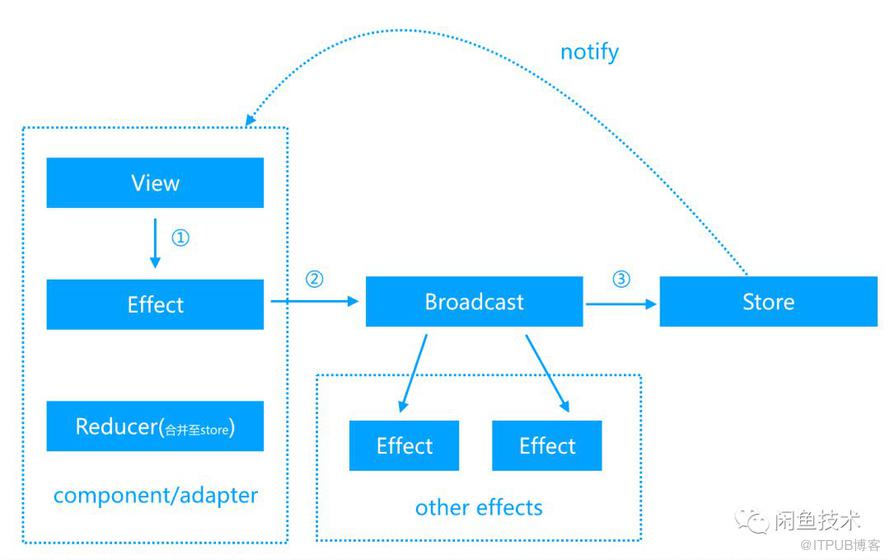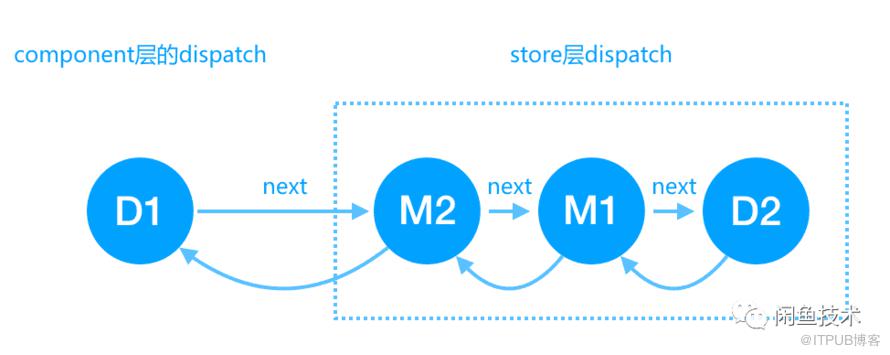您好,登錄后才能下訂單哦!
您好,登錄后才能下訂單哦!
這篇文章主要為大家展示了“Fish Redux中的Dispatch如何實現”,內容簡而易懂,條理清晰,希望能夠幫助大家解決疑惑,下面讓小編帶領大家一起研究并學習一下“Fish Redux中的Dispatch如何實現”這篇文章吧。
我們在使用fish-redux構建應用的時候,界面代碼(view)和事件的處理邏輯(reducer,effect)是完全解耦的,界面需要處理事件的時候將action分發給對應的事件處理邏輯去進行處理,而這個分發的過程就是下面要講的dispatch, 通過本篇的內容,你可以更深刻的理解一個action是如何一步步去進行分發的。
為了更好的理解action的dispatch過程,我們就先以todolistpage中一條todo條目的勾選事件為例,來看點擊后事件的傳遞過程,通過斷點debug我們很容易就能夠發現點擊時候發生的一切,具體過程如下:
用戶點擊勾選框,GestureDetector的onTap會被回調
通過buildView傳入的dispatch函數對doneAction進行分發,發現todo_component的effect中無法處理此doneAction,所以將其交給pageStore的dispatch繼續進行分發
pageStore的dispatch會將action交給reducer進行處理,故doneAction對應的_markDone會被執行,對state進行clone,并修改clone后的state的狀態,然后將這個全新的state返回
然后pageStore的dispatch會通知所有的listeners,其中負責界面重繪的_viewUpdater發現state發生變化,通知界面進行重繪更新
Dispatch在fish-redux中的定義如下
typedef Dispatch = void Function(Action action);
本質上就是一個action的處理函數,接受一個action,然后對action進行分發。
下面我門通過源碼來進行詳細的分析。
0component->ComponentWidget->ComponentState->_mainCtx->_dispatch而 _mainCtx的初始化則是通過componet的createContext方法來創建的,順著方法下去我們看到了dispatch的初始化
// redux_component/context.dart DefaultContext初始化方法
DefaultContext({
@required this.factors,
@required this.store,
@required BuildContext buildContext,
@required this.getState,
}) : assert(factors != null),
assert(store != null),
assert(buildContext != null),
assert(getState != null),
_buildContext = buildContext {
final OnAction onAction = factors.createHandlerOnAction(this);
/// create Dispatch
_dispatch = factors.createDispatch(onAction, this, store.dispatch);
/// Register inter-component broadcast
_onBroadcast =
factors.createHandlerOnBroadcast(onAction, this, store.dispatch);
registerOnDisposed(store.registerReceiver(_onBroadcast));
}
context中的dispatch是通過factors來進行創建的,factors其實就是當前component,factors創建dispatch的時候傳入了onAction函數,以及context自己和store的dispatch。onAction主要是進行Effect處理。這邊還可以看到,進行context初始化的最后,還將自己的onAction包裝注冊到store的廣播中去,這樣就可以接收到別人發出的action廣播。
Component繼承自Logic
// redux_component/logic.dart
@override
Dispatch createDispatch(
OnAction onAction, Context<T> ctx, Dispatch parentDispatch) {
Dispatch dispatch = (Action action) {
throw Exception(
'Dispatching while appending your effect & onError to dispatch is not allowed.');
};
/// attach to store.dispatch
dispatch = _applyOnAction<T>(onAction, ctx)(
dispatch: (Action action) => dispatch(action),
getState: () => ctx.state,
)(parentDispatch);
return dispatch;
}
static Middleware<T> _applyOnAction<T>(OnAction onAction, Context<T> ctx) {
return ({Dispatch dispatch, Get<T> getState}) {
return (Dispatch next) {
return (Action action) {
final Object result = onAction?.call(action);
if (result != null && result != false) {
return;
}
//skip-lifecycle-actions
if (action.type is Lifecycle) {
return;
}
if (!shouldBeInterruptedBeforeReducer(action)) {
ctx.pageBroadcast(action);
}
next(action);
};
};
};
}
}

上面分發的邏輯大概可以通過上圖來表示
通過onAction將action交給component對應的effect進行處理
當effect無法處理此action,且此action非lifecycle-actions,且不需中斷則廣播給當前Page的其余所有effects
最后就是繼續將action分發給store的dispatch(parentDispatch傳入的其實就是store.dispatch)
0
// redux/create_store.dart
final Dispatch dispatch = (Action action) {
_throwIfNot(action != null, 'Expected the action to be non-null value.');
_throwIfNot(
action.type != null, 'Expected the action.type to be non-null value.');
_throwIfNot(!isDispatching, 'Reducers may not dispatch actions.');
try {
isDispatching = true;
state = reducer(state, action);
} finally {
isDispatching = false;
}
final List<_VoidCallback> _notifyListeners = listeners.toList(
growable: false,
);
for (_VoidCallback listener in _notifyListeners) {
listener();
}
notifyController.add(state);
};
store的dispatch過程比較簡單,主要就是進行reducer的調用,處理完成后通知監聽者。
0
// redux_component/component.dart
Widget buildPage(P param) {
return wrapper(_PageWidget<T>(
component: this,
storeBuilder: () => createPageStore<T>(
initState(param),
reducer,
applyMiddleware<T>(buildMiddleware(middleware)),
),
));
}
// redux_component/page_store.dart
PageStore<T> createPageStore<T>(T preloadedState, Reducer<T> reducer,
[StoreEnhancer<T> enhancer]) =>
_PageStore<T>(createStore(preloadedState, reducer, enhancer));
// redux/create_store.dart
Store<T> createStore<T>(T preloadedState, Reducer<T> reducer,
[StoreEnhancer<T> enhancer]) =>
enhancer != null
? enhancer(_createStore)(preloadedState, reducer)
: _createStore(preloadedState, reducer);
所以這里可以看到,當傳入enhancer時,createStore的工作被enhancer代理了,會返回一個經過enhancer處理過的store。而PageStore創建的時候傳入的是中間件的enhancer。
// redux/apply_middleware.dart
StoreEnhancer<T> applyMiddleware<T>(List<Middleware<T>> middleware) {
return middleware == null || middleware.isEmpty
? null
: (StoreCreator<T> creator) => (T initState, Reducer<T> reducer) {
assert(middleware != null && middleware.isNotEmpty);
final Store<T> store = creator(initState, reducer);
final Dispatch initialValue = store.dispatch;
store.dispatch = (Action action) {
throw Exception(
'Dispatching while constructing your middleware is not allowed. '
'Other middleware would not be applied to this dispatch.');
};
store.dispatch = middleware
.map((Middleware<T> middleware) => middleware(
dispatch: (Action action) => store.dispatch(action),
getState: store.getState,
))
.fold(
initialValue,
(Dispatch previousValue,
Dispatch Function(Dispatch) element) =>
element(previousValue),
);
return store;
};
}
這里的邏輯其實就是將所有的middleware的處理函數都串到store的dispatch,這樣當store進行dispatch的時候所有的中間件的處理函數也會被調用。下面為各個處理函數的執行順序,

首先還是component中的dispatch D1 會被執行,然后傳遞給store的dispatch,而此時store的dispatch已經經過中間件的增強,所以會執行中間件的處理函數,最終store的原始dispatch函數D2會被執行。
以上是“Fish Redux中的Dispatch如何實現”這篇文章的所有內容,感謝各位的閱讀!相信大家都有了一定的了解,希望分享的內容對大家有所幫助,如果還想學習更多知識,歡迎關注億速云行業資訊頻道!
免責聲明:本站發布的內容(圖片、視頻和文字)以原創、轉載和分享為主,文章觀點不代表本網站立場,如果涉及侵權請聯系站長郵箱:is@yisu.com進行舉報,并提供相關證據,一經查實,將立刻刪除涉嫌侵權內容。